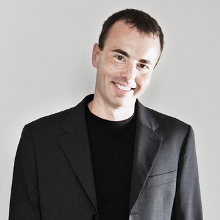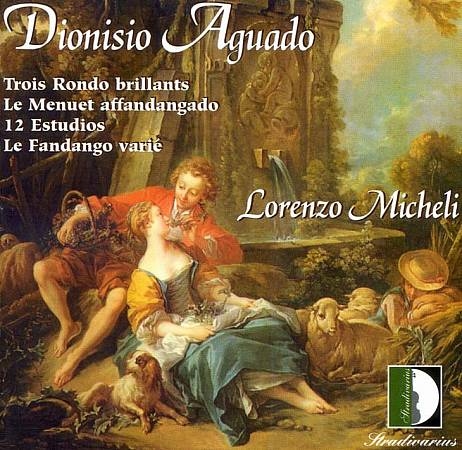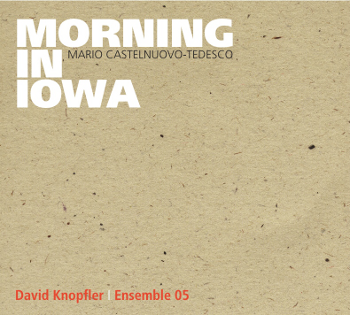
Fine Classical, Instrumental, and Specialty Recordings
Label: Stradivarius Item Number: STR-33563 Format: CD Dionisio Aguado: Guitar Music Lorenzo Micheli
Lorenzo Micheli - Guitar  Hailed by the musical critics as "virtuoso extraordinaire" (Nice Matin), "absolutely astonishing" (Fort Worth Star-Telegram), "prodigious talent" (Soundboard), Lorenzo Micheli, theorbist and guitarist, has taken up a busy concert career throughout the world since winning the first prize in some of the most prestigious guitar competitions (Gargnano, Alessandria, Guitar Foundation of America). He performs regularly - both as a soloist and with orchestra - in Europe and all over the US and Canada, as well as in Africa, Asia and Latin America. As a researcher and scholar, he has written articles and contributions for a number of music journals, including Il Fronimo and Guitar Forum. He has been performing worldwide in duo with Matteo Mela, as "SoloDuo", in such venues as New York"™s Carnegie Hall, Dublin"™s National Concert Hall and Vienna"™s Konzerthaus. Their guitar duo was welcomed by The Washington Post as "nothing less than rapturous", and The New York Concert Review wrote about their Carnegie Hall debut: "It is hard to say what left more of an impression: their remarkable blend, their sublime artistry or their impeccable technique. Do not miss a chance to hear them." His discography include the music of Dionisio Aguado, the Quartets, op. 19, by François de Fossa and a CD of Italian music of the 17th century for baroque guitar, archlute and theorbo (Stradivarius); the complete guitar Concertos by Mario Castelnuovo-Tedesco (Brilliant); a couple of live DVD"™s (Mel Bay); a selection of guitar music by Castelnuovo-Tedesco, the complete works by Miguel Llobet and the Duos Concertants by Antoine de Lhoyer (Naxos); an anthology of chamber works by Mauro Giuliani (Amadeus), and two collections of 19th and 20th century masterpieces for two guitars (Noesis and Solaria, Pomegranate Music). Lorenzo is guitar professor at the Conservatory of Aosta, Italy. Definito "l"™esecutore ideale dello strumento"; (Enzo Siciliano, Il Venerdì di Repubblica) e "prodigious talent" (Soundboard), Lorenzo Micheli, chitarrista e tiorbista, ha vinto alcuni tra i più importanti concorsi di interpretazione del mondo (Gargnano, Alessandria, Guitar Foundation of America). Dopo gli studi con Paola Coppi a Milano, Frédéric Zigante a Losanna e Oscar Ghiglia alla Musik-Akademie di Basilea, Lorenzo ha intrapreso un"™intensa attività artistica - come solista e con orchestra - che lo ha portato in tutta Europa (Spagna, Irlanda, Croazia, Austria, Svizzera, Estonia, Francia, Grecia, Polonia, Gran Bretagna, Finlandia, Slovenia, Norvegia, Ucraina, Slovacchia, Repubblica Ceca, Germania, Turchia, Olanda), in Canada e in oltre cento città statunitensi, in Estremo Oriente, in Africa e in America Latina. Tiene regolarmente masterclass per Università e Festival americani ed europei, ha registrato per radio e televisioni di quattro continenti e pubblicato saggi e contributi su riviste specializzate italiane e straniere, quali Il Fronimo e Guitar Forum. Insieme a Matteo Mela, Lorenzo Micheli ha suonato nelle sale da concerto di tutto il mondo, dalla Carnegie Hall di New York alla Konzerthaus di Vienna: il Washington Post ha salutato il loro duo come "nothing less than rapturous". Per Stradivarius Lorenzo ha registrato una monografia sulle opere per chitarra sola di Dionisio Aguado, una sui Quartetti op. 19 di François de Fossa e una sulla musica italiana del Seicento per tiorba e chitarra barocca; per NAXOS sono usciti un CD dedicato alla musica di Mario Castelnuovo-Tedesco, i Duos Concertants di Antoine de Lhoyer e l"™integrale delle opere di Miguel Llobet; Brilliant Records ha dato alle stampe la sua registrazione integrale dei Concerti di Castelnuovo-Tedesco, la rivista Amadeus un doppio disco sulla musica da camera di Mauro Giuliani e l"™etichetta Pomegranate Music due antologie di opere dell"™Ottocento e del Novecento (Noesis e Solaria). Lorenzo Micheli insegna presso l"™Istituto Musicale Pareggiato della Valle d"™Aosta. Between the XVIII and XIX century, throughout Europe the guitar began to win back the popularity it had not enjoyed for nearly a hundred years and again became a common sight everywhere. The capital cities of music par excellence Paris and Vienna were soon to become the major centre of this phenomenon, particularly from just before 1810 until 1840, when they became a veritable hive of activity. This revival of the guitar's fortunes was the work of virtuoso performers, mainly from Italy and Spain, who taught, composed and gave concerts up and down the continent. The pre-eminence of Paris and Vienna was in no small part due to the presence there of the greatest guitarists of the nineteenth century: the Catalan Fernando Sor and his favourite pupil Napoléon Coste, Dionisio Aguado from Madrid, Ferdinando Carulli and Francesco Molino from Italy were all active in Paris, while Mauro Giuliani was the guitarist to be reckoned with in Vienna (although Giuliani's reputation subsequently fell into disrepute and his work was rediscovered and its true worth recognized only in the 1960's). Dionisio Aguado occupies a prominent position in this renaissance of the guitar, but the corpus of his works has only recently become the subject of careful study by specialists and musicologists. This is surprising, since guitarists have always had a great affection for Aguado, particularly because of his methods on which he worked for his whole life. Then again, perhaps it is the great worth itself of his methods and systems of playing technique - which remain highly relevant even today - that somehow managed to overshadow Aguado's concert pieces: a situation this record is intended to rectify. Dionisio Aguado was born in Madrid on 8 april 1784 into a well-to-do family. While still young and studying humanities as would any other boy of his background, Dionisio embarked on the study of the guitar under the guide of the Cistercian Father Basilio, a somewhat mysterious figure who was to exert a great influence over many disciples. In Madrid in 1820, Aguado published his Escuela de guitarra, the first of a long series of didactic works. Six years later, in 1826, he moved to Paris, the destination that artists and musicians of his day aspired to, and where he was to reside for almost thirteen years, dividing his time between concert performances (as a soloist and as a duo with his friend Fernando Sor) and teaching, and where he was to produce all his major works. As the years went by, there were fewer and fewer reports of any appearances in concert, however, and Aguado returned to Spain in 1838, devoting himself to teaching and to the preparation of his Nuevo Metodo para guitarra (1843). This large-scale work was intended to collect and set down in an organic, systematic manner the enormous wealth of teaching experience the composer had built up over the years and to which he was constantly adding new elements through his tireless application to his art, right up until his death in 1849. Dionisio Aguado's output is recognizably different from those guitarists-composers who were his contemporaries insofar as he devoted himself exclusively to the guitar: he left neither chamber music nor concertos nor further compositions intended for other instruments. And Aguado was equally unlike the guitarists of his time in that he saw nothing wrong in infusing "classical" music with the tone colour and phrasing of the popular Spanish tradition. The Trois Rondos Brillants, op. 2, were published in Paris by Meissonier in 1825 and are dedicated to François de Fossa, an officer in the French army, guitarist and composer (to whom we owe, among the other things, the survival of the manuscripts of the Quintets for guitar and strings by Luigi Boccherini). As was often the case in the repertoire of the early 1800's, the work which was dedicated to a major guitarist was no mere routine exercise churned out to keep the publishers happy. The structure is three "diptyches", in which a slow introductory movement is followed by a fast one - in other words the "rondo" itself. Aguado's op. 2 is undoubtedly his most significant concert piece for his breadth of form, inspiration and a highly original approach to the instrument. Indeed, all of these elements combine to make it one of the greatest virtuoso pieces for the guitar ever. The Menuet Affandangado, op. 15 (published in Paris between 1835 and 1838 and also dedicated to De Fossa) is a curious experiment in musical "grafting" in which the composer combines the form of a minuet with the rythm of a fandango, employing a theme and variations (preceded by the usual slow introduction) in which the emphasis constantly shifts back and forth between the two forms. Le Fandango varié, op. 16, was published in Paris between 1835 and 1838 and is based far more openly on this folk dance which originated in the late seventeenth century. The fandango was danced mainly to an accompaniment of guitars and castanets and has always been one of the mainstays of the music of Spain; its markedly rhytmic character makes it ideal for long displays of improvisation and off-the-cut bravura. In the wake of Antonio Soler and Luigi Boccherini, Aguado produces a sort of transcription of an improvisation on a fandango rhythm, and this use of a folk music tradition again illustrates the closeness and influence on each other of classical and non-classical music. The choice of 12 out of the 27 estudios contained in the Nuevo Metodo (Madrid, 1843) aims to bring to light the musical value of pieces originally intended for teaching, but in which invention, compositional originality and pure melody go far beyond the scope of the average student exercise. A number of these pieces are also unusually difficult for guitarists to play, which fully justifies their place in the repertoire today alongside the great concert studies. Frédéric Zigante
Label: Stradivarius Item Number: STR-33563 Format: CD Dionisio Aguado occupies a prominent position among the great guitarists of the nineteenth century, but the corpus of his works has only recently become the subject of careful study by specialists and musicologists. This is surprising, since guitarists have always had a great affection for Aguado, particularly because of his technical methods. However, these somehow managed to overshadow Aguado's concert pieces: a situation this record is intended to rectify. Not Available | |||||||||||||||||||||||||||||||||||||||||||||||||||||||||||||||||||||||||||||||||||||||||||||||||||


 Follow Us on Twitter
Follow Us on Twitter Follow Us on Instagram
Follow Us on Instagram Visit Our Partner Soundset Recordings
Visit Our Partner Soundset Recordings